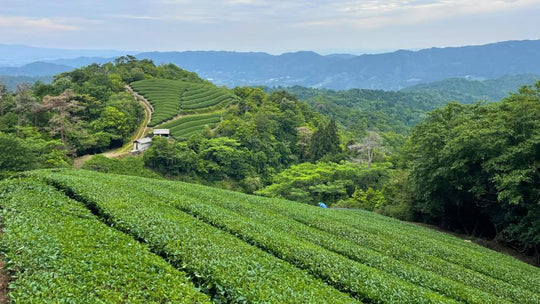
Matcha Shortage & Price Surge in Japan 2025 – What's Really Happening?
Posted on July 08 2025,

What’s happening, what caused it, and what to expect next
If you’ve recently tried to buy matcha—especially high-grade ceremonial matcha—you may have noticed something unusual: rising prices, limited availability, and delayed shipments.
We’re based in Japan and work directly with tea farmers and wholesalers. Here's a clear breakdown of what’s going on and what it means for our industry and customers worldwide.
📉 Matcha Supply is Down — By a Lot

Matcha is made from tencha, a type of shaded green tea leaf. The 2025 harvest in Kyoto Prefecture, the heart of Uji matcha, saw steep production drops:
| Tea Type | 2024 Volume | 2025 Volume | Change |
|---|---|---|---|
| Uji Tencha (hand-picked) | 10,216 kg | 6,140 kg | –40% |
| First-harvest Tencha (machine-picked) | 529,960 kg | 434,521 kg | –18% |
These numbers were officially reported by the Kyoto Tea Industry Association and JA Zen-Noh Kyoto in June 2025.
💴 Prices Have More Than Doubled

With supply tight and global demand stronger than ever, prices at auction skyrocketed:
| Tea Type | 2024 Price/kg | 2025 Price/kg | Change |
|---|---|---|---|
| Uji Tencha | ¥20,024 | ¥43,330 | +116% |
| First-harvest Tencha | ¥5,402 | ¥14,541 | +169% |
These price hikes are unprecedented and have already begun to affect product pricing and availability worldwide.
🔍 What’s Driving the Shortage?
The shortage isn’t due to a single issue—it's a perfect storm:
1. Global Matcha Demand Is Booming
Health-conscious consumers are fueling demand for matcha in all forms—from traditional tea bowls to matcha lattes, smoothies, sweets, and supplements. Even the food service and cosmetic industries are using more matcha than ever before.
2. Climate & Agricultural Challenges
Japan saw unusually hot and dry spring weather in 2025. Some regions reported stress to tea plants, affecting leaf quality and yield. This is especially true in Kyoto, where traditional, non-mechanized growing methods are still common.
3. Shift in Tea Production Priorities
To meet demand, many farms are switching from producing gyokuro or sencha to tencha (the raw material for matcha). While this shift is strategic, it also reduces diversity and limits output in the short term.
4. Cost of Materials & Labor
Fuel, packaging, fertilizer, and labor costs have all gone up. Combined with the weak yen, production is more expensive than ever, especially for organic and hand-picked teas.
🗾What Does National Data Show?
Interestingly, nationwide tencha production has increased over the past decade. According to Japan’s Ministry of Agriculture, 2024 tencha output was 2.7x higher than in 2014.
But that’s only part of the story: Kyoto—home to the most prized Uji matcha—saw dramatic drops in 2025. So while the total supply across Japan is up, the best quality matcha is now in short supply.
🔮 What to Expect Going Forward
At Premium Health Japan, we’ve been fielding many questions from customers and partners around the world. Here’s what we believe you can expect:
✅ Prices Will Remain High—For Now
Tencha and matcha prices won’t return to 2022 levels anytime soon. However, some stabilization may come after the autumn harvest, or with larger spring yields in 2026.
✅ Supply Chains Are Being Adjusted
Farmers, auction houses, and buyers are all adapting. There’s more focus on improving yields, replanting tea fields, and modernizing production while maintaining quality.
✅ Matcha is Not Going Away
Despite the shock, Japan’s matcha industry is strong. Smart investment, strategic growth, and international demand will ensure that authentic matcha continues to be available, though you may need to be more selective.
💬 What We’re Doing at Premium Health Japan
We’re proud to operate directly in Japan, working face-to-face with producers. We’ve secured strong relationships with farmers, cooperatives, and millers, which means:
-
We source our tea directly from Uji-based farms, including rare, hand-picked cultivars.
-
We’ve already adjusted pricing to reflect current auction rates.
-
We minimize waste, store efficiently, and ship globally from our hubs in Japan, the USA, the EU, and Australia.
If you're a wholesale buyer or OEM partner, we can guide you through current options and expected lead times.
In Summary
| Key Issue | Details |
|---|---|
| Supply | Uji tencha down 40–60% in 2025 |
| Prices | Auction prices up 116–169% YoY |
| Drivers | Climate impact, booming demand, higher costs |
| Outlook | Supply recovery possible in 2026–2028 |
| What We Offer | Direct Kyoto sourcing, reliable distribution, complete transparency |
📌 Additional Sources
We recommend reading these non-commercial articles for more background:
Have questions about our products, OEM options, or pricing?
We’re happy to help. Contact us, and our bilingual team will respond to you.
